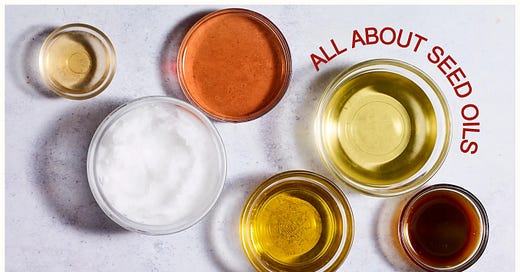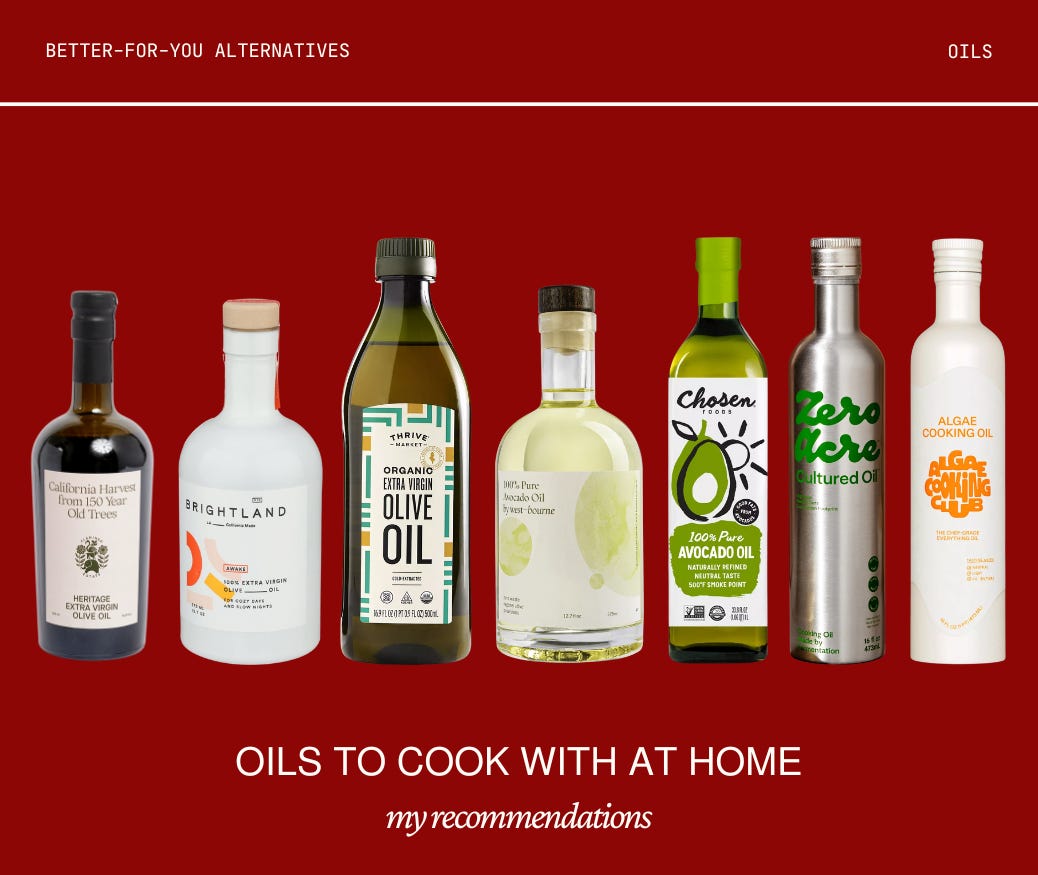
Seed oils have become one of the most polarizing topics in the nutrition world—villainized by some, staunchly defended by others, and utterly confusing to the rest of us. If you've ever wondered whether you should be more serious about avoiding canola or soybean oil or if the debate is just another sensationalized wellness trend, you're not alone.
So, let’s break it down—minus the extremes and internet yelling—and take a look at what seed oils actually are, how they’re made, and how they may (or may not) impact your health.
First, What Are Seed Oils?
“Seed oils” typically refer to oils extracted from—ding ding ding—seeds. The most common ones include:
Sunflower seed oil
Canola (rapeseed) oil
Corn oil
Cottonseed oil
Safflower oil
Grapeseed oil
Soybean oil
These oils are all over processed foods—from chips and cookies to salad dressings, oat milk, frozen meals, and more. They're popular in food manufacturing and restaurants because they're cheap, shelf-stable, and have no flavor. But, are they good for you?
The 3 Big Issues With Industrial Seed Oils
Here is a breakdown of what I see as the 3 primary issues with seed oils:
1. Processing
Most industrial seed oils undergo a refining process that not only strips away the original nutrients in the seeds, but also changes the oil's structure. This process typically includes:
High-heat processing: High temperatures can degrade nutrients, like vitamin E and alter fatty acid structures.
Use of chemical solvents (like hexane): This help increase the yield of conventional oils. The oil is “washed” later in the process to get rid of the solvent, but trace amounts can still be present.
Chemical deodorization and bleaching: This creates a clear, unscented oil but could create trace amounts of trans fats.
Preservatives: Some oils will contain synthetic preservatives like BHA, BHT, and TBHQ to prevent oxidation.
2. Omega-6 Overload
Seed oils are high in omega-6 fatty acids. While these are essential fats (your body needs them!), too much—especially without enough omega-3s—can tip the body toward a pro-inflammatory state.
Ideally our omega-6 to omega-3 ratio would be between 1:1 and 4:1. This means you could have 4 times as many omega-6s as omega-3s and still be within a healthy range. However, the average American diet clocks in a ratio of around 15:1 or more. This imbalance has been linked to many modern chronic diseases, including:
Chronic inflammation
Insulin resistance
Obesity
Cardiovascular disease
3. The Bigger Food Context—It’s About More Than The Oil
Seed oils rarely show up in isolation. They’re most often found in ultra-processed, fried, and shelf-stable foods—things that also tend to be high in:
Refined carbs
Additives and preservatives
Artificial flavors and colors
So the health issues may stem not from the oils alone, but the entire package they come in—as well as what they often replace in the diet: whole foods.
What the Science (and Controversy) Says
Part of the controversy around seed oils is that there hasn’t been a single, conclusive study directly linking them to poor health outcomes. However, we do know that overconsumption of ultra-processed foods—the ones that most often contain seed oils—is strongly associated with chronic inflammation, insulin resistance, and obesity. So while seed oils may not be directly to blame (or proven to be), they’re often part of a bigger dietary pattern that is linked to poor health.
“But Aren’t Sunflower Seeds Healthy?”
Great question. A whole sunflower seed is indeed very healthy and rich in protein, fiber, healthy fats, and micronutrients. But when highly refined and stripped down into oil, those nutrients are largely lost—and we’re left with an processed food product that’s very different from its whole-food beginnings.
Advocates of seed oils often highlight their polyunsaturated fat (PUFA) content, which has been shown to support heart health—especially when they replace saturated fats. But this benefit is mostly seen in the context of improving poor-quality diets, not optimizing healthy ones. For someone eating a whole-food diet rich in plants, fiber, and high-quality protein, the argument for adding seed oils becomes much less compelling.
Polyunsaturated fats are also less stable, meaning they’re more prone to oxidation. This process creates harmful and inflammatory byproducts—like aldehydes—that can damage cells. It’s what happens when the oil in a deep fryer isn’t changed often enough (sorry for ruining those fries for you!), when that bottle of sunflower oil sits too long in your pantry, or even when you microwave leftover food or takeout cooked in seed oils.
That said, if you’re eating a balanced, nutrient-dense diet (ahem—we’ve got lots of resources for that here on Btwn Meals, including all the recipes in my Sunday Meal Prep series), a little seed oil—especially if it’s expeller-pressed and organic—is pretty harmless. Context and quality matters.
So… What Can You Do?
Avoiding seed oils entirely in today’s food landscape is almost impossible. But you can make simple changes that support better health outcomes and help rebalance your omega-6 to omega-3 intake:
1. Skip Seed Oils at Home (and eat more home-cooked meals!)
Instead, opt for:
Extra Virgin Olive Oil (Flamingo Estate, Brightland, Thrive Market)
Avocado Oil (Westbourne, Chosen Foods)
Zero Acre—derived from fermented sugarcane plants! - has no sugar, btw.
Algae Cooking Club—chef-grade algae-based cooking oils with a high smoke point.
When I might make an exception:
Expeller pressed, organic and regenerative sunflower oil—like La Tournagelle
Toasted sesame oil—I love a little toasted sesame oil in asian-inspired dressings, as a garnish for stir fries or other dishes to add flavor an depth.
Dining out
If you dine out often, you can ask for your food to be prepared with olive oil and request olive oil and vinegar instead of dressings that likely contain seed oils (restaurant-dependent, of course). Some restaurant shout-outs:🤌 Sweetgreen is working to eliminate all seed oils. They don’t use them for cooking (including fries), but I believe that are still in some of their dressings.
🤌 True Food Kitchen is a seed oil-free restaurant (that also delivers!).
2. Prioritize Quality Animal Protein
Grass-fed, pasture-raised, and wild animal and seafood products have a much healthier fat profile than conventional grain-fed ones. Grains are an omega-6 source and the fatty acid makeup of these animal-based foods is very much influenced by the animal’s diet. Here are a few examples (these are estimates):
Grass-fed vs grain-fed beef (omega-6:omega-3 ratio):
Grass-fed beef: ~2:1
Grain-fed beef: between 15:1 and 20:1
Wild or sustainably-farmed vs conventionally-farmed salmon:
Wild and sustainably farmed salmon: ~0.2:1
Conventionally farmed salmon: ~0.8:1
Pasture-raised vs conventional (grain-fed) chicken:
Pasture-raised chicken: ~5:1
Conventional chicken: as high as 30:1 (yikes!)
Pasture-raised eggs vs conventional eggs (from grain-fed chickens):
Pasture-raised eggs: ~1:1 or 2:1
Conventional eggs: ~20:1
Some of my favorite ways to shop quality animal proteins are through: Buy Ranch Direct, Butcher Box, Pasture Project (discount code: MIARIGDEN15) and Seatopia (discount code: MIA_RIGDEN). Your local farmers market is another great option!
3. Eat More Omega-3 Rich Foods
This helps naturally rebalance your omega-6 to omega-3 ratio. Some good sources include:
Wild-caught fatty fish (use the acronym SMASH—salmon, mackerel, anchovies, sardines, and herring)
Flax and chia seeds
Walnuts
Eggs
Avocado
4. Consider Omega-3 Supplementation
High-quality fish oil or algae oil supplements can help bridge the gap—especially if you don’t eat fish or are still transitioning away from processed foods.
I personally like Needed’s Omega-3 supplement, and algae-based omega-3s are great plant-based options.
If you found this post informative and would like to see more like it, please consider tapping the heart or sharing it with your community.
And if you have thoughts, light up the comments!! I’d love to hear from you and answer any questions you might have.
xx Mia











Thank you for this! SUPER helpful given all of the news. Even my dad is talking about seed oils now.
Lest we forget palm oil! This is extremely informative. Thank you for taking the time to research and break it all down in a way that is simple to understand and, most importantly, actionable!